青少版新概念2a unit 知识点总结
新概念英语青少版2A知识点整理
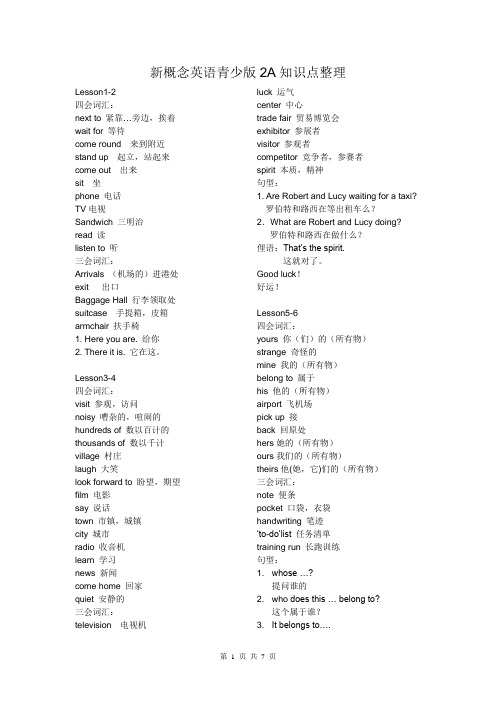
新概念英语青少版2A知识点整理Lesson1-2四会词汇:next to 紧靠…旁边,挨着wait for 等待come round 来到附近stand up 起立,站起来come out 出来sit 坐phone 电话TV电视Sandwich 三明治read 读listen to 听三会词汇:Arrivals (机场的)进港处exit 出口Baggage Hall 行李领取处suitcase 手提箱,皮箱armchair 扶手椅1. Here you are. 给你2. There it is. 它在这。
Lesson3-4四会词汇:visit 参观,访问noisy 嘈杂的,喧闹的hundreds of 数以百计的thousands of 数以千计village 村庄laugh 大笑look forward to 盼望,期望film 电影say 说话town 市镇,城镇city 城市radio 收音机learn 学习news 新闻come home 回家quiet 安静的三会词汇:television 电视机luck 运气center 中心trade fair 贸易博览会exhibitor 参展者visitor 参观者competitor 竞争者,参赛者spirit 本质,精神句型:1. Are Robert and Lucy waiting for a taxi? 罗伯特和路西在等出租车么?2.What are Robert and Lucy doing?罗伯特和路西在做什么?俚语:That’s the spirit.这就对了。
Good luck!好运!Lesson5-6四会词汇:yours 你(们)的(所有物)strange 奇怪的mine 我的(所有物)belong to 属于his 他的(所有物)airport 飞机场pick up 接back 回原处hers她的(所有物)ours我们的(所有物)theirs他(她,它)们的(所有物)三会词汇:note 便条pocket 口袋,衣袋handwriting 笔迹‘to-do’list 任务清单training run 长跑训练句型:1. whose …?提问谁的2. who does this … belong to?这个属于谁?3. It belongs to….它属于…1. let sb. do sth.2. give sb. sth. / give sth. to sb.Lesson 7-8四会词汇:hour 小时put on 穿上walk 走take off 脱下turn on 打开turn off 关掉letter 信throw away 扔掉三会词汇top three percent 最好的百分之三volunteer 自愿者Congratulations! 祝贺Well done! 做得很好!foil jacket 保暖夹克hero英雄this way 这边medal 奖章put up 挂起curtain 窗帘take down 拿下picture 图画so 非常pleased 高兴的Best wishes 最美好的祝福句型:1. Are you going to have a drink?你打算去喝些东西么?2. I’m going to have lunch.我打算去吃午餐。
青少版新概念英语2A教学重点

★Where were sb. and sb. an hour ago
They were at….
★一般过去时
定义:一般过去时表示过去某个时间发生的动作或存在的状态。常和表示过去的时间状语连用。如:last year(去年), yesterday(昨天)等;也可表示过去经常反复发生的动作,常和often, always等频率副词连用。
★时间表达法
&
……past/to……
半小时以内含半小时,用past,半小时以后用to。
Unit 6
An elegant size
P44
P46
★When do sb. and sb. do sth.
:
Unit 7
A good example
,
P52
P54
★How many times a week does he go to the cinema
P28
P30
★Don't take your gloves off.
,
★祈使句
表建议,命令,请求等,省略主语,直接用谓语动词开头。
Unit 5
All about ants!
【
P36
P38
★What time is it / What's the time
It's ….
★When do you…
I usually….at….
★一般过去时
定义:一般过去时表示过去某个时间发生的动作或存在的状态。常和表示过去的时间状语连用。如:last year(去年), yesterday(昨天)等;也可表示过去经常反复发生的动作,常和often, always等频率副词连用。
青少版新概念英语2A
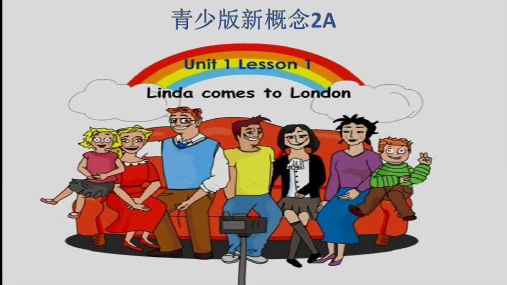
Make a new dailogue.
B A: Hi,_____._________________? B: I'm in the_____________next to the Arrivals exit. Are you waiting for your suitcase? C A: Yes, I'm in the ___________. Is _____with you? B: Yes, of course he/she is.I’m giving him/her my phone now. Here you are, ______. Talk to your friend! C C: Hello, ____.Welcome to _______. A A: Hello,_____. I’ve got my suitcase, and I’m coming out now! C
青少版新概念英语2A Unit 1 Linda comes to London
New Words and Expressions 生词和短语
next to[‘nekst tu] prep.紧靠……旁边 come round [kʌm raund] v.+adv来到附近 Arrivals [ə'raɪvəlz]n. (机场的)进港口 stand [stænd] v.站立 exit [ˈegsɪt] n. 出口 phone [fəʊn]n. 电话 wait for v.+prep 等待 come out v.+adv 出来 Baggage Hall [ˈbægɪdʒ hɔ:l] 行李领取厅 suitcase [ˈsu:tkeɪs] n. 手提箱,皮箱 sit [sɪt]v. 坐
新概念英语青少版2Aunit9

Unit 9: Do your own thing一:课文重点:1.Do your own thing. 惯用语:独立做自己的事。
2.I t’s going to be a very early start. It :主语不提供任何信息,居首位是因为英语句子必须有主语和动词,It’s early. It’s half past ten.可以表示时间,距离,天气,等。
3.want: want to do, want me to do, want是及物动词,后面如果没有宾语,意思就不完整,其宾语可以是名词,代词,或者带to的动词不定式。
4.can’t: 表示不允许,禁止,into the Red Zone: into表示进入一个区域或空间,the red zone限制进入的其他区域。
5.The National Athletics Championships: 国家田径锦标赛,(复合名词)Athletic:运动的,体育的,Athletics:田径,体育运动,复合名词中第一个名词在形式上通常是单数,但是athletics 同gymnastics, Mathematics ,Physics等一样,常用复数形式。
二:家长监督:听课文五遍,跟读三遍,单词三遍,并做练习册。
三:预习:Unit 10Unit 10 Tomorrow’s another day!一:课文重点1.题目:传统的谚语,意思是让我们活在现在,不必考虑明天的事情。
2.remember:大多数情况下,remember和know,hear,see, smell, understand 一样,指的是状态和感受。
但是有时也可以指回忆:I am remembering the good times. 我在回忆好时光。
3.take: her jobs take her all over the world. Take在这里是“搬到某处去”的意思,all over the world 遍布世界。
(完整word版)青少版新概念2AUnit1知识点总结.docx

辅导讲义学员姓名: Jnce2a年级:科目: Jnce1b学科教师:Bella 授课日期2018.6.9授课时段周六8:00-10:00授课主题Unit 1 Linda comes to London教学内容课前回顾包括上次的后作解、听写、重、日校答疑、重点回等⋯⋯Unit法:1.介短2.a+量 +of+名3.在行————一般疑句肯否定回答,述句句型4.在分化基本构: be+doing(do代指所有原形)肯定句:主+am/is/are+doing......My mother is talking with the dentist.否定句:主+am/is/are not+doing...They aren’tplaying games.一般疑句:Is/Are+主 +doing...? Yes,主 +am/is/are...Is she waiting for a bus?No,主 +am/is/are not.特殊疑句:特殊疑+is/are+主 +doing....?Where are they doing their homework?在分化:1)一般情况下 ,直接在后加- ingwork ---- working sleep ----- sleeping study ----- studying2)以不音的- e 尾 ,要去- e 加- ingtake ----- taking make ----- making dance ----- dancing3)重音的 ,要双写尾字母 ,再加- ingcut ----- cutting put ----- putting begin ------ beginning4)以- ie 尾的 ,把成 y 再加- ing lie -----lying tie ----- tying die ----- dying:next to 靠⋯旁,挨着 wait for 等待 come round 来到附近 stand up 起立,站起来 come out 出来 sit 坐 phone TV Sandwich 三明治 read listen to 听Arrivals (机的)港exit出口Baggage Hall行李取suitcase 手提箱,皮箱armchair扶手椅重点句型:★ What are you doing?I'm ⋯.★ What is sb. doing?He / She is ⋯.★Is Paul eating a sandwich?★What is Paul doing?作:1.微信熟 P.2.背短,下听写3.完成册4.每天听音料 10 分并大声跟。
新概念青少版2A各单元重点归纳
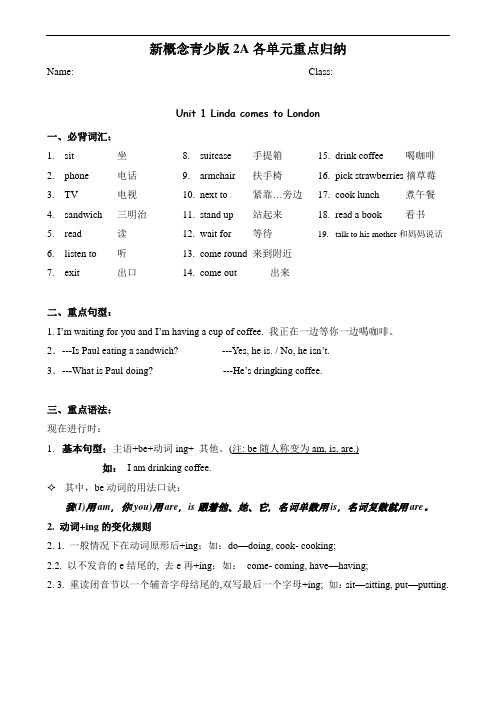
新概念青少版2A各单元重点归纳Name:___________________ Class:___________________Unit 1 Linda comes to London一、必背词汇:1.sit 坐2.phone 电话 电视4.sandwich 三明治5.read 读6.listen to 听7.exit 出口8.suitcase 手提箱9.armchair 扶手椅10.next to 紧靠…旁边11.stand up 站起来12.wait for 等待e round 来到附近e out 出来15.drink coffee 喝咖啡16.pick strawberries摘草莓17.cook lunch 煮午餐18.read a book 看书19.talk to his mother和妈妈说话二、重点句型:1. I’m waiting for you and I’m having a cup of coffee. 我正在一边等你一边喝咖啡。
2.---Is Paul eating a sandwich? ---Yes, he is. / No, he isn’t.3.---What is Paul doing? ---He’s dringking coffee.三、重点语法:现在进行时:1.基本句型:主语+be+动词ing+ 其他。
(注: be随人称变为am, is, are.)如:I am drinking coffee.其中,be动词的用法口诀:我(I)用am,你(you)用are,is跟着他、她、它,名词单数用is,名词复数就用are。
2. 动词+ing的变化规则2. 1. 一般情况下在动词原形后+ing;如:do—doing, cook- cooking;2.2. 以不发音的e结尾的, 去e再+ing;如:come- coming, have—having;2. 3. 重读闭音节以一个辅音字母结尾的,双写最后一个字母+ing; 如:sit—sitting, put—putting.Unit 2 Good luck on Sunday!一、重点词汇:1.visit 参观,访问2.visitor 参观者3.noisy 嘈杂的4.village 村庄ugh 大笑6.film 电影7.say 说话8.town 市镇,城镇9.city 城市10.radio 收音机11.learn 学习12.news 新闻13.quiet 安静的14.television 电视机15.luck 运气16.center 中心e home 回家18.listen to the radio听收音机19.learn English 学习英语20.watch the news 看新闻21.play football 踢足球22.have lunch 吃午餐23.go out 外出24.hundreds of 数以百计的25.thousands of 数以千计26.look forward to 盼望,期望二、重点句型:1. --- Are Robert and Lucy waiting for a taxi? 罗伯特和露西在等出租车么?---Yes, they are. / No, they aren’t.2. ---What are Robert and Lucy doing? 罗伯特和露西在做什么?--- They are waiting for a bus. 他们正在等公交车。
新概念英语青少版2A Unit 12 The London bus学习资料
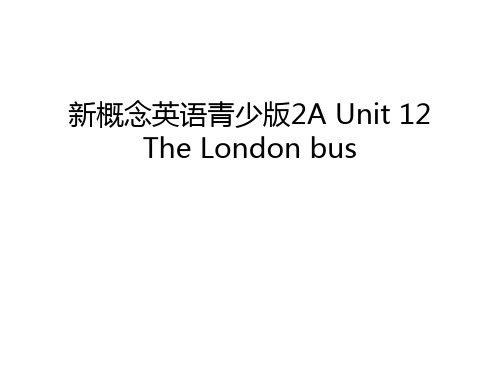
Practise saying some years
• 1900 • 1805 • 1936 • 1999 • 2000 • 2001 • 2012
nineteen hundred nineteen hundred and five nineteen thirty six
• some years ago, agoபைடு நூலகம்通常和表示一段时间的词或短 语连用,表示“在...之前”
Unit 12 The London bus
• Today , Londoners remember the Routemaster’s name. They remember the designer’s name: Douglas Scott.
hate 一般用法:hate to do/hate doing e.g: I hate going to the theatre.
I hate to come in the middle
Unit 12 The London bus
• The first Routemaster were on our roads in 1954. The last official Routemaster journey was on Route Number 9,on 15th February 2006.That was some years ago.
Notes on the Text
• in, 通常后接大的地点,或者是时间,如: 世纪,年,月;也可以跟早、下、晚。
• e.g: in 1985/ in the morning • 提示:当早、下和晚前有修饰词时,要用
青少版新概念2a___unit

What is she doing?
• wait for a bus
• She is waiting for a bus.
shine • The sun is shining.
现在进行时
• 结构 • 否定句: • 主语+be动词+not+V-ing+其
他
讲下面的句子改为否定句
• I'm waiting for you. • I'm not waiting for you. • I'm having a cup of tea. • I'm not having a cup of tea. • I'm coming out now! • I'm not coming out now!
4. A: Is Paul standing beside Karen? B: Yes, he is. A: Who is standing beside Karen? B: Paul is.
5. A: Is Linda coming out now with her suitcase? B: Yes, she is. A: Who is coming out now with her suitcase?
•c) 1.She is in the Baggage Hall. •2.She is waiting for her suitcase. • 3.Yes, she can. •4.It is coming round now. •5.He’s standing beside Karen. •6.Karen is giving her phone to Paul. •7.Linda has got her suitcase now.
青少版新概念英语2A教学重点

Chocolate heaven!
P108
P110
★Did sb. Have any…?
Yes, I / He / She / They / You did.
No, I / He / She / They / You didn't.
★How many / much…did sb. Have?
★Why are you going to…?
Because….
Unit 9
Do your own thing
P68
P70
★What do you want to do?
I want to….
★What do you want sb. to do?
I want sb. to….
★Why do you want sb. to do sth.?
Unit 2
Good luck on Sundaபைடு நூலகம்!
P12
P14
★Who are waiting for a bus?
★What are they doing?
They're……
★What are sb. and sb. doing?
They're…...
★现在进行时
定义:表示此时此刻正在进行的动作。
★时间表达法
……past/to……
半小时以内含半小时,用past,半小时以后用to。
Unit 6
An elegant size
P44
P46
★When do sb. and sb. do sth.?
Unit 7
A good example
P52
P54
青少版新概念2A知识点 (1)

青少版新概念2A知识点 (1)
本文档旨在总结和记录《青少版新概念英语第二册A》课程的主要知识点。
以下是课程中的重点内容:
单词
- 单词的拼写和发音是研究英语的基础。
第二册A涵盖了一系列常用的单词,包括名词、动词和形容词等。
请确保掌握每个单词的意思、拼写和正确的发音。
句子构造
- 本册课程将帮助研究者构建简单的句子。
重点包括主谓宾结构、形容词和副词的使用,以及简单的否定和疑问句。
请在研究过程中多加练,并熟悉不同句子类型的表达方式。
语法
- 语法是建立正确句子的基础。
在本册课程中,我们将研究一些基本的语法规则,如一般现在时、一般过去时和现在进行时等。
请确保掌握这些基础知识,并能够正确运用于实际场景中。
阅读理解
- 阅读理解是提高英语水平的重要方面。
通过阅读并理解文章、故事和对话,研究者可以提升词汇量和阅读理解能力。
本册课程将
提供一系列适合青少年的阅读材料,帮助研究者培养阅读技巧。
口语表达
- 语言是用来交流的工具,口语表达能力是研究英语的重要目
标之一。
通过课程中的口语练和对话,研究者将提高自己的口语表
达能力,培养与他人交流的信心。
以上是《青少版新概念英语第二册A》课程的主要知识点总结。
希望通过这些内容的学习,学习者们能够掌握基本的英语语法和词汇,并提高自己的阅读理解和口语表达能力。
新概念青少版2A各单元重点归纳

新概念青少版2A各单元重点归纳Name:___________________ Class:___________________Unit 1 Linda comes to London一、必背词汇:1.sit 坐2.phone 电话 电视4.sandwich 三明治5.read 读6.listen to 听7.exit 出口8.suitcase 手提箱9.armchair 扶手椅10.next to 紧靠…旁边11.stand up 站起来12.wait for 等待e round 来到附近e out 出来15.drink coffee 喝咖啡16.pick strawberries摘草莓17.cook lunch 煮午餐18.read a book 看书19.talk to his mother和妈妈说话二、重点句型:1. I’m waiting for you and I’m having a cup of coffee. 我正在一边等你一边喝咖啡。
2.---Is Paul eating a sandwich? ---Yes, he is. / No, he isn’t.3.---What is Paul doing? ---He’s dringking coffee.三、重点语法:现在进行时:1.基本句型:主语+be+动词ing+ 其他。
(注: be随人称变为am, is, are.)如:I am drinking coffee.其中,be动词的用法口诀:我(I)用am,你(you)用are,is跟着他、她、它,名词单数用is,名词复数就用are。
2. 动词+ing的变化规则2. 1. 一般情况下在动词原形后+ing;如:do—doing, cook- cooking;2.2. 以不发音的e结尾的, 去e再+ing;如:come- coming, have—having;2. 3. 重读闭音节以一个辅音字母结尾的,双写最后一个字母+ing; 如:sit—sitting, put—putting.Unit 2 Good luck on Sunday!一、重点词汇:1.visit 参观,访问2.visitor 参观者3.noisy 嘈杂的4.village 村庄ugh 大笑6.film 电影7.say 说话8.town 市镇,城镇9.city 城市10.radio 收音机11.learn 学习12.news 新闻13.quiet 安静的14.television 电视机15.luck 运气16.center 中心e home 回家18.listen to the radio听收音机19.learn English 学习英语20.watch the news 看新闻21.play football 踢足球22.have lunch 吃午餐23.go out 外出24.hundreds of 数以百计的25.thousands of 数以千计26.look forward to 盼望,期望二、重点句型:1. --- Are Robert and Lucy waiting for a taxi? 罗伯特和露西在等出租车么?---Yes, they are. / No, they aren’t.2. ---What are Robert and Lucy doing? 罗伯特和露西在做什么?--- They are waiting for a bus. 他们正在等公交车。
青少版新概念英语2A教学重点

青少版新概念英语2A教学重点Teaching Focus for New Concept English 2A for Young LearnersUnit 1: ___Unit 2: Wishing Good Luck on SundayKey Vocabulary:Page 4Page 6Page 12Page 14Key ___ Structures:What are you doing。
I'm。
What is he/she doing。
He/She is。
Who is waiting for the bus?What are they doing。
They're。
What are they doing。
They're。
Whose is this。
It'___'s.Who does this belong to。
It ___.Don't take your gloves off.___:Present continuous ___: It describes an n that is ___。
The structure is "be verb + verb + -ing" (present participle).Subject pronouns。
object pronouns。
possessive pronouns (both noun and adjective forms).Unit 3: Is This Yours?Unit 4: The Top Three ___Unit 5: All About Ants!Unit 6: The Perfect SizePage 20Page 22Page 28Page 30Page 36Page 38Key ___ Structures:___: They express ns。
(完整版)新概念青少版2A复习总结(语法)

新概念2A总复习Part 1 时态1、基本结构:be+doing (do代指所有动词原形)肯定句:主语+am/is/are+doing......My mother is talking with the dentist.否定句:主语+am/is/are not+doing...They aren’t playing games.一般疑问句:Is/Are+主语+doing...? Yes,主语+am/is/are...Is she waiting for a bus? No,主语+am/is/are not.特殊疑问句:特殊疑问词+is/are+主语+doing....?Where are they doing their homework?2、动词现在分词变化规则:1)一般情况下,直接在动词后加-ingwork ---- working sleep ----- sleeping study ----- studying2) 动词以不发音的-e结尾,要去-e加-ingtake ----- taking make ----- making dance ----- dancing3) 重读闭音节的动词,要双写词尾字母,再加-ingcut ----- cutting put ----- putting begin ------ beginning4) 以-ie结尾的动词,把变成y再加-inglie ----- lying tie ----- tying die ----- dying①表示客观事实、真理②经常发生、有规律的事情1、基本结构:①带有be动词: 主语+am/is/are+肯定句:主语+am/is/are+n./adj./prep.短语...The sky is blue.My music book is in the bag.否定句:主语+am/is/are not+n./adj./prep.短语...It isn’t my magazine.The curtain isn’t clean.一般疑问句:Is/Are+主语+n./adj./prep.短语...? Yes,主语+am/is/are.Are these gloves yours? No,主语+am/is/are not.Is there any water in the jug?特殊疑问句:特殊疑问词+is/are+主语+n./adj./prep.短语....?Which one is right?Who is the man in a black hat?②带有实义动词:主语+(never/sometimes/often/usually/always)v.原形/v.三单+....(every morning/day/week.)肯定句:主语+v.原形/三单+.......They usually live in dry places. It sometimes rains in summer. 否定句:主语+don’t /doesn’t +v.原形+....... We don’t go to school on weekends.一般疑问句:Do/Does+主语+v.原形.......? Yes,主语+do/does.Do you always arrive at school very early? No,主语+don’t/doesn’t. Does Lucy have a rest every afternoon?特殊疑问句:特殊疑问词+do/does+主语+v.原形.......?Why does she always arrive so late? 2、动词第三人陈单数变化规则: 1)一般直接在动词尾直接加 s.如: play —plays, want —wants, work —works,know —knows,help —helps, get —gets2)以字母s 、x 、ch 、sh 结尾的动词加-es guess—guesses,fix—fixes,teach—teaches,brush—brushes,watch—watches,catch—catches3)以辅音字母+y 结尾的动词,先变y 为i,再加-es.发音/z/如:study—studies,carry—carries,fly—flies,worry—worries1、学生们在干什么?有一些在打电话,另一些躺在沙滩上。
青少版新概念英语2A教学重点
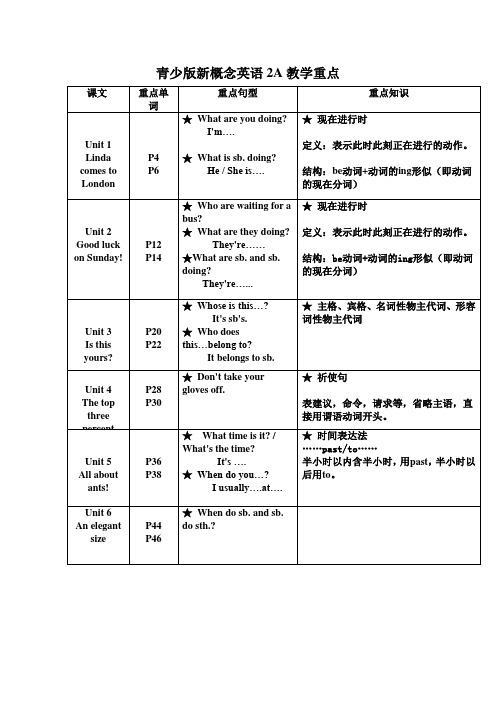
答:这个垃圾场不仅要能填埋垃圾,而且要能防止周围环境和地下水的污染。★Was Robert at school yesterday?
Yes, he is. / No, he isn't.
六年级下册科学复习资料★Were you at school yesterday?
14、在太阳周围的八颗大行星,它们是水星、金星、地球、火星、木星、土星、天王星、海王星。Yes, I was. / No, I wasn't.
Unit 2
Good luck on Sunday!
P12
P14
★Who are waiting for a bus?
★What are they doing?
They're……
★What are sb. and sb. doing?
They're…...
★现在进行时
定义:表示此时此刻正在进行的动作。
Unit 13
The Kalenjin
P100
P102
★Was there any…last month?
Yes, there was. / No, there wasn't.
★Were there any…last month?
Yes, there were. / No, there weren't.
7、硫酸铜溶液与铁钉的反应属于化学反应。硫酸铜溶液的颜色是蓝色,将铁钉浸入硫酸铜溶液中,我们发现铁钉变红了。
4、小苏打和白醋混合后,产生了一种新物质——二氧化碳气体,这种气体能使燃着的火焰熄灭,这样的变化属于化学变化。
5、月球在圆缺变化过程中出现的各种形状叫作月相。月相变化是由于月球公转而发生的。它其实是人们从地球上看到的月球被太阳照亮的部分。P84
新概念英语青少版-2A语法大全
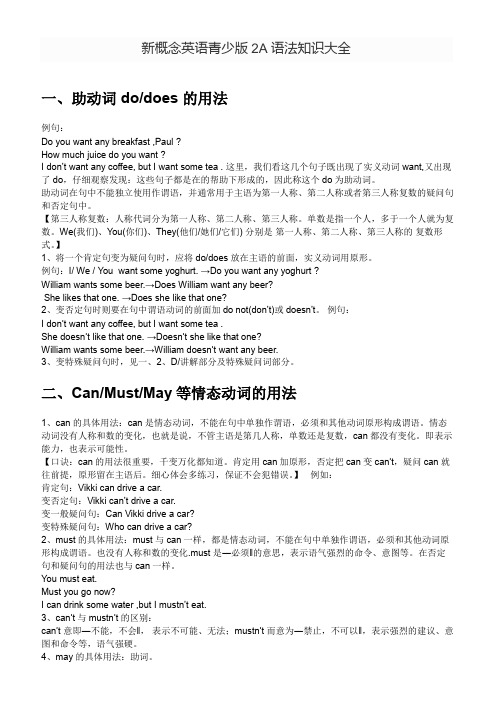
新概念英语青少版2A语法知识大全一、助动词 do/does 的用法例句:Do you want any breakfast ,Paul ?How much juice do you want ?I don’t want any coffee, but I want some tea . 这里,我们看这几个句子既出现了实义动词want,又出现了do,仔细观察发现:这些句子都是在的帮助下形成的,因此称这个do为助动词。
助动词在句中不能独立使用作谓语,并通常用于主语为第一人称、第二人称或者第三人称复数的疑问句和否定句中。
【第三人称复数:人称代词分为第一人称、第二人称、第三人称。
单数是指一个人,多于一个人就为复数。
We(我们)、You(你们)、They(他们/她们/它们) 分别是第一人称、第二人称、第三人称的复数形式。
】1、将一个肯定句变为疑问句时,应将do/does放在主语的前面,实义动词用原形。
例句:I/ We / You want some yoghurt. →Do you want any yoghurt ?William wants some beer.→Does William want any beer?She likes that one. →Does she like that one?2、变否定句时则要在句中谓语动词的前面加do not(don’t)或doesn’t。
例句:I don‘t want any coffee, but I want some tea .She doesn‘t like that one. →Doesn‘t she like that one?William wants some beer.→William doesn‘t want any beer.3、变特殊疑问句时,见一、2、D/讲解部分及特殊疑问词部分。
二、Can/Must/May等情态动词的用法1、can的具体用法:can是情态动词,不能在句中单独作谓语,必须和其他动词原形构成谓语。
(完整版)青少版新概念2Aunit10知识点总结.docx
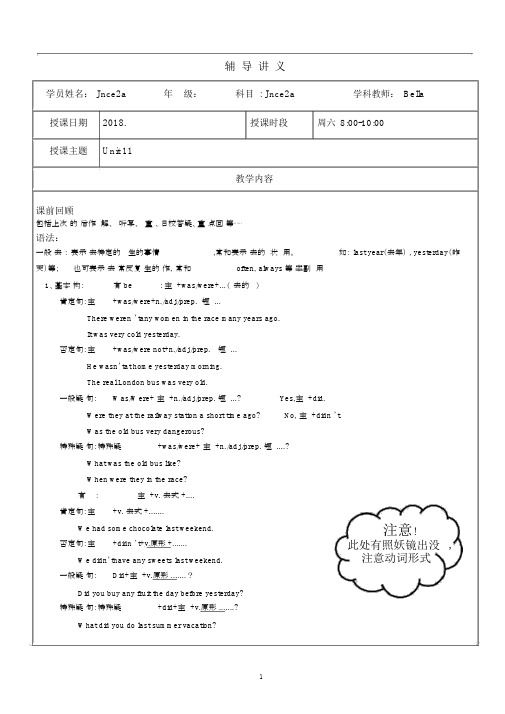
辅导讲义学员姓名: Jnce2a年级:科目: Jnce2a学科教师:Bella授课日期2018.授课时段周六8:00-10:00授课主题Unit 11教学内容课前回顾包括上次的后作解、听写、重、日校答疑、重点回等⋯⋯语法:一般去:表示去特定的生的事情,常和表示去的状用。
如:last year(去年), yesterday(昨天)等;也可表示去常反复生的作,常和often, always 等率副用1、基本构:有be: 主 +was/were+...( 去的 )肯定句:主+was/were+n./adj./prep. 短 ...There weren ’tany women in the race many years ago.It was very cold yesterday.否定句:主+was/were not+n./adj./prep.短...He wasn’tat home yesterday morning.The real London bus was very old.一般疑句:Was/Were+ 主 +n./adj./prep. 短 ...?Yes,主 +did.Were they at the railway station a short time ago?No, 主 +didn ’t.Was the old bus very dangerous?特殊疑句:特殊疑+was/were+ 主 +n./adj./prep. 短 ....?What was the old bus like?When were they in the race?有:主+v.去式+....肯定句:主+v.去式 +.......We had some chocolate last weekend.否定句:主+didn ’t+v.原形 +.......We didn’thave any sweets last weekend.一般疑句:Did+主 +v.原形 .......?Did you buy any fruit the day before yesterday?特殊疑句:特殊疑+did+主 +v.原形 .......?注意!此处有照妖镜出没,注意动词形式What did you do last summer vacation?2、动词过去式变化规则:1)一般情况下,动词词尾加-ed, 如:work— worked play— played want — wanted ask— asked2)以不发音的 -e 结尾动词,动词词尾加-d, 如:-ed 发音 :清辅音后 /t/浊辅音和元音后 /d/ t/d 后/id/live— lived move— moved taste— tasted3)以“辅音字母 +y”结尾的动词,把y 改成 i, 加— ed, 如:study— studies try — tried copy— copied carry —carried4)重读闭音节动词,双写词尾辅音字母,再加—ed, 如:stop— stopped5)常用不规则动词过去式am,is,was have hadare were do dideat ate go wentgive gave read readfeel felt come camebuy bought fly flewdrive drove ride rodeput put sell soldsee saw get gotsit sat hang hungbring brought become becamebreak broke take tookcut cut meet metleave left say saidrun ran tell toldsleep slept write wrotewin won find found1.I _________ (have) an exciting party last weekend.2._________ she _________(practice) her guitar yesterday?No, she _________.3.What ________ Tom ________ (do) on Saturday evening?He ________(watch) TV and __________(read) an interesting book.4.They all _________(go) to the mountains yesterday morning.5.She _________(not visit) her aunt last weekend.She ________ (stay) at home and _________(do) some cleaning.6.Jenny 喜欢看书。
最新青少版新概念英语2A教学重点(1)

P30
★Don't take your gloves off.
★祈使句
表建议,命令,请求等,省略主语,直接用谓语动词开头。
Unit 5
All about ants!
P36
P38
★What time is it? / What's the time?
It's ….
★When do you…?
I usually….at….
★时间表达法
……past/to……
半小时以内含半小时,用past,半小时以后用to。
Unit 6
An elegant size
P44
P46
★When do sb. and sb. do sth.?
Unit 7
A good example
P52
P54
★How many times a week does he go to the cinema?
★一般过去时
定义:一般过去时表示过去某个时间发生的动作或存在的状态。常和表示过去的时间状语连用。如:last year(去年), yesterday(昨天)等;也可表示过去经常反复发生的动作,常和often, always等频率副词连用。
“碧芝”的成功归于他的唯一,这独一无二的物品就吸引了各种女性的眼光。
3、竞争对手分析
Unit 12
TheLondonbus
P92
P94
★Were sb. and sb. at school an hour ago?
Yes, they were. / No, they weren't.
★Where were sb. and sb. an hour ago?
新概念英语青少版2A单词表总结.doc
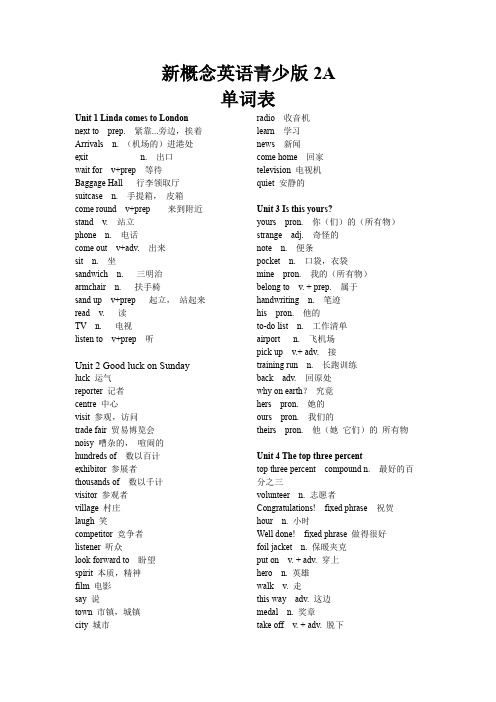
新概念英语青少版2A单词表Unit 1 Linda comes to London next to prep. 紧靠...旁边,挨着Arrivals n. (机场的)进港处exit n. 出口wait for v+prep 等待Baggage Hall 行李领取厅suitcase n. 手提箱,皮箱come round v+prep 来到附近stand v. 站立phone n. 电话come out v+adv. 出来sit n. 坐sandwich n. 三明治armchair n. 扶手椅sand up v+prep 起立,站起来read v. 读TV n. 电视listen to v+prep 听Unit 2 Good luck on Sunday luck 运气reporter 记者centre 中心visit 参观,访问trade fair 贸易博览会noisy 嘈杂的,喧闹的hundreds of 数以百计exhibitor 参展者thousands of 数以千计visitor 参观者village 村庄laugh 笑competitor 竞争者listener 听众look forward to 盼望spirit 本质,精神film 电影say 说town 市镇,城镇city 城市radio 收音机learn 学习news 新闻come home 回家television 电视机quiet 安静的Unit 3 Is this yours?yours pron. 你(们)的(所有物)strange adj. 奇怪的note n. 便条pocket n. 口袋,衣袋mine pron. 我的(所有物)belong to v. + prep. 属于handwriting n. 笔迹his pron. 他的to-do list n. 工作清单airport n. 飞机场pick up v.+ adv. 接training run n. 长跑训练back adv. 回原处why on earth?究竟hers pron. 她的ours pron. 我们的theirs pron. 他(她它们)的所有物Unit 4 The top three percenttop three percent compound n. 最好的百分之三volunteer n. 志愿者Congratulations! fixed phrase 祝贺hour n. 小时Well done! fixed phrase 做得很好foil jacket n. 保暖夹克put on v. + adv. 穿上hero n. 英雄walk v. 走this way adv. 这边medal n. 奖章take off v. + adv. 脱下turn on v. + adv. 打开turn off v. + adv. 关掉letter n. 信throw away v. + adv. 扔掉put up v. + adv. 挂起curtain n. 窗帘,门帘take down v. + adv. 拿下picture n. 画,图画so adv. 非常,多么pleased adj。
- 1、下载文档前请自行甄别文档内容的完整性,平台不提供额外的编辑、内容补充、找答案等附加服务。
- 2、"仅部分预览"的文档,不可在线预览部分如存在完整性等问题,可反馈申请退款(可完整预览的文档不适用该条件!)。
- 3、如文档侵犯您的权益,请联系客服反馈,我们会尽快为您处理(人工客服工作时间:9:00-18:30)。
★Whatareyoudoing?I'm….
★Whatissb.doing?He/Sheis….
★Is Paul eating a sandwich?
★What is Paul doing?
作业:
1.微信熟读P.
2.背诵单词短语,下节课听大声跟读。
辅导讲义
学员姓名:Jnce2a年级:科目:Jnce1b学科教师:Bella
授课日期
2018.6.9
授课时段
周六8:00-10:00
授课主题
Unit1 Linda comes to London
教学内容
课前回顾
包括上次课的课后作业讲解、单词听写、错题重现、日校答疑、重难点回顾等……
Unit
语法:
1.介词短语
词汇:
next to紧靠…旁边,挨着wait for等待come round来到附近
stand up起立,站起来come out出来sit坐phone电话
TV电视Sandwich三明治read读listen to听
Arrivals(机场的)进港处exit出口Baggage Hall行李领取处
suitcase手提箱,皮箱armchair扶手椅
2.a+量词+of+名词
3.现在进行时————一般疑问句肯否定回答,陈述句句型
4.现在分词变化规则
基本结构:be+doing(do代指所有动词原形)
肯定句:主语+am/is/are+doing......
My mother is talking with the dentist.
否定句:主语+am/is/are not+doing...
动词现在分词变化规则:
1)一般情况下,直接在动词后加-ingwork ---- workingsleep ----- sleepingstudy ----- studying2)动词以不发音的-e结尾,要去-e加-ingtake ----- takingmake ----- makingdance----- dancing3)重读闭音节的动词,要双写词尾字母,再加-ingcut ----- cuttingput ----- puttingbegin ------ beginning4)以-ie结尾的动词,把变成y再加-inglie ----- lyingtie ----- tyingdie ----- dying
They aren’t playing games.
一般疑问句:Is/Are+主语+doing...? Yes,主语+am/is/are...
Is she waiting for a bus? No,主语+am/is/are not.
特殊疑问句:特殊疑问词+is/are+主语+doing....?
Where are they doing their homework?
